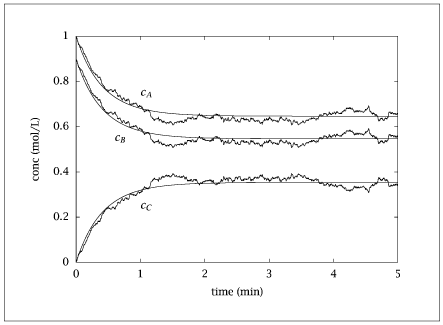1
2
3
4
5
6
7
8
9
10
11
12
13
14
15
16
17
18
19
20
21
22
23
24
25
26
27
28
29
30
31
32
33
34
35
36
37
38
39
40
41
42
43
44
45
46
47
48
49
50
51
52
53
54
55
56
57
58
59
60
61
62
63
64
65
66
67
68
69
70
71
72
73
74
75
76
77
78
79
80
81
82
83
84
85
86
87
88
89
90
91
92
93
94
95
96
97
98
99
100
101
102
103
104
105
106
107
108
109 | % Copyright (C) 2001, James B. Rawlings and John G. Ekerdt
%
% This program is free software; you can redistribute it and/or
% modify it under the terms of the GNU General Public License as
% published by the Free Software Foundation; either version 2, or (at
% your option) any later version.
%
% This program is distributed in the hope that it will be useful, but
% WITHOUT ANY WARRANTY; without even the implied warranty of
% MERCHANTABILITY or FITNESS FOR A PARTICULAR PURPOSE. See the GNU
% General Public License for more details.
%
% You should have received a copy of the GNU General Public License
% along with this program; see the file COPYING. If not, write to
% the Free Software Foundation, 59 Temple Place - Suite 330, Boston,
% MA 02111-1307, USA.
%
% Revised 7/24/2018
%
% add a stochastic simulation using Gillespie's algorithm
%
% example 1: A + B --> C
% C --> A + B
%
nmolec = 400;
k1 = 1;
k2 = 1;
k(1) = k1/(nmolec);
k(2) = k2;
stoi = [-1 -1 1;
1 1 -1];
[nrxs,nspec] = size(stoi);
clear x
x(1,1) = nmolec;
x(2,1) = 0.9*nmolec;
x(3,1) = 0*nmolec;
stoiT = stoi';
nsim = nmolec*4;
clear time
time = zeros(nsim+1,1);
time(1) = 0;
rand('seed', 0);
for n=1:nsim
r(1) = k(1)*x(1,n)*x(2,n);
r(2) = k(2)*x(3,n);
rtot = sum(r);
pp = rand(2,1);
tau = -log(pp(1))/rtot;
time(n+1) = time(n) + tau;
% determine which reaction (mth) is likely to occur
m = sum (cumsum (r) <= pp(2)*rtot) + 1;
x(:,n+1) = x(:,n) + stoiT(:,m);
end
%
% scale so ca0=1;
%
[ts,xs] = stairs(time, x');
ts = ts(:,1);
xscale = xs ./ xs(1,1);
%plot(time,xscale')
%
% make a deterministic comparison for nonlinear example 1.
%
ca0 = x(1,1)/x(1,1);
cb0 = x(2,1)/x(1,1);
cc0 = x(3,1)/x(1,1);
timedet = [0; (logspace (-4,1,100)')];
k1det = k1;
k2det = k2;
%
% analytical if k2det = 0
%
% delc = ca0-cb0;
% ca = delc ./ ( 1 - cb0/ca0 .* exp(-delc*k1det .* timedet));
% cb = ca - delc;
% cc = - ca + ( cc0 + ca0);
p = struct(); % Create structure to pass parameters to fsolve function
p.ca0 = ca0;
p.cb0 = cb0;
p.cc0 = cc0;
p.k1det = k1det;
p.k2det = k2det;
opts = odeset ('AbsTol', sqrt (eps), 'RelTol', sqrt (eps));
[tsolver, ca] = ode15s(@(t,x) f(t,x,p), time, ca0, opts);
cb = ca - ca0 + cb0;
cc = cc0 + ca0 - ca;
%plot(timedet, [ca,cb,cc])
table1 = [ts xscale];
table2 = [time ca cb cc];
save stochnon.dat table1 table2;
if (~ strcmp (getenv ('OMIT_PLOTS'), 'true')) % PLOTTING
plot (table1(:,1),table1(:,2:4), table2(:,1), table2(:,2:4));
axis ([0, 5, 0, 1]);
% TITLE
end % PLOTTING
|
